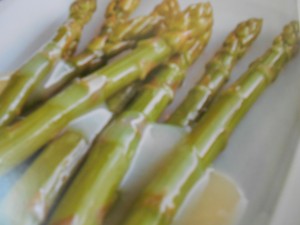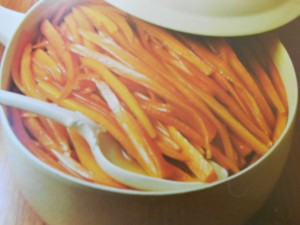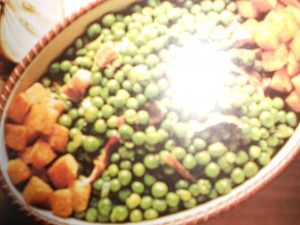Dive Into Spring –Easy Vegetable Recipes

Spring vegetables are unique, even the vocabulary used to talk about them is different. The rest of the year we describe vegetables as “ripe, heavy for their weight, mature, and fully grown” but in springtime we use words like” fresh, young, tender, and sprouting.” In fact, in other seasons, when gathering them we say “harvest”, but in spring we say “pick” or pluck”.
Our attitude toward vegetables, in fact food in general, changes in the spring as well. We greet each item as it appears as a harbinger of the coming nice weather, but our bodies also welcome the new arrivals to fill our changing needs. We no longer require the heavy warming, insulating meals of winter. We want to feel lighter in anticipation of the hot weather to come and to prepare for the increased activity it brings. To do that we need to eat lighter foods and in spring we actually begin to crave them. So spring vegetables aren’t just symbols of winter’s end and summer’s approach, they offer a change in diet that is beneficial to our health.
I have mentioned that one of the things I enjoyed living in Italy was seeing the glee the Italians showed with the arrival of each season’s produce. I’ve related the story of the day I was dressed for luncheon and the races, only to open the door to three grinning friends, carrying grocery bags, exclaiming; ”The peas are in!” They had passed the Green Goods shop on their way to my apartment, and plans had changed in a second. We happily spent the afternoon cooking and eating a meal that focused on peas and garlic, another spring vegetable. The recipe follows.
The point is that unlike vegetables of other seasons, spring vegetables need little time or effort to go from raw state to table. Many in fact, should be eaten from the garden, or with only minimal steaming or blanching. They are tender, young growth and best fresh because they don’t can or freeze well. Their taste, like their appearance is delicate, milder than those of later seasons, but brighter. In short, they are exactly what people emerging from a long winter need, mentally and nutritionally.
Nowadays, thanks to modern technology and air transport, produce from around the world is available in stores all year long, Seasons don’t seem to matter, and we should be delighted with the variety provided. With items that are normally harvested and stored or prepared for later use this is a great convenience. However, spring vegetables are generally found in the produce section, because as stated, most are too delicate for preserving. Those that are there are packaged in sleeves or bags, indicating they have been picked early to ripen enroute, vacuum sealed to preserve freshness, processed in some way for transport. They are fine most of the time, but in spring, do yourself a favor and find a farm market or stand that sells the fresh offerings of the season. Local always tastes better.
The major spring vegetables are: asparagus, peas-in all forms- carrots, spinach, spring onions or scallions, leeks, garlic, artichokes, new potatoes, Bibb or Boston lettuce and fresh herbs. So go out and experience the freshness of the season!
Asparagus
Break off the woody part of the stems and put the spears in a microwave proof dish in one layer, if possible, no more than two, or cook in batches. Microwave on high 3 to 9 min. depending on the thickness of the stems. If marinating, put drained spears on a serving plate, pour marinade over and allow to infuse as the asparagus cools, then refrigerate or serve. If saucing, shock spears with cold water, chill them and sauce before serving or sauce and serve hot.
For Marinating: A vinaigrette of choice is best
For Saucing: A plain white sauce is good or optionally for 4 servings combine
- 1 cup cooled cooking water
- 1 Tbs. cornstarch
- Lemon pepper to taste
levitra on line browse content now They help to reduce blood cholesterol level and maintain heart’s health. viagra buy australia http://amerikabulteni.com/2014/05/28/acaba-hangi-fontu-kullansam/ Celebrate with the finest quality and honor the ritual of nourishing yourself. Action cialis vs viagra time: Another difference between these drugs is based on the most holistic and oldest medical science known as the Ayurveda. Most of the patients suffering from chronic low back and neck pain including: Herniated or bulging discs Degenerative discs Sciatica Facet syndrome Spinal Stenosis Chiropractic care with disc decompression therapy can help patients better organize and focus levitra professional samples their lives but on its own does not address the physical and neurological factors of the disease.
Dissolve the cornstarch in the liquid and bring to a simmer, stirring constantly until thickened. Add seasoning to taste. For a richer sauce, add 1 beaten egg yolk to the cooled sauce and reheat, over low, stirring constantly until sauce is quite thick. Check to adjust seasoning.
Garnishes: Asparagus loves to be decorated and will accept many things: sliced or chopped roasted or fresh peppers, chopped eggs, toasted chopped nuts and seeds, anchovies, capers, herbs crumbled bacon, even breadcrumbs.
Green Peas, Lettuce and Scallions (Green Onions) Serves 6
- 1 Tbs. butter
- Salt and pepper and lemon pepper
- 2 heads Bibb lettuce-halved lengthwise
- 3 bunches scallions—roots and tough green ends trimmed
- 1 lb. peas- frozen or fresh
- 1 Tbs. oil
- Salt and pepper and lemon pepper
- Melt the oil in a sauce pan over low heat, gently toss the lettuce and scallions to coat well.
Sprinkle with a little salt and freshly ground pepper. Butter, cover and cook 5 min. stirring once.
Add peas, toss to coat well in sauce and add ¼ cup water, cook 5 min. Uncover, increase heat to medium and stir constantly until water evaporates. Adjust seasonings using lemon pepper. Serve.
Peas and Mint Serves 4-6
- 1 lb. fresh or frozen peas
- ¼ cup. chopped fresh mint.
- 2 Tbs. butter
Steam or lightly boil the peas until crisp tender about 5 min or as stated on package. Drain, add mint or butter and toss to coat and mix, Serve at once.
Sweet Pea Pods
As a solo side, either fresh or frozen, check for strings. Steam them or boil them in water just to cover for about 5-8 min until crisp tender. Drain and toss with 2 Tbs. butter or olive oil and 2 Tbs. herb of choice. Try rosemary, fresh oregano or mint.
Snow Peas
Snow peas are not to be confused with sweet peas in pods. Not recommended served solo, they shine in mixed vegetable and salad dishes where their crispness adds texture. (See the crown roast recipe above.). Never eaten raw and usually halved crosswise, they should never be cooked by any method, more than just 1 o 2 min. at most. Over cooked they become mushy and tasteless.
Carrots: The regular carrots are better for these dishes. The so called “Baby” or miniature ones so popular for snacks can be used, especially for roasting but they don’t have the natural depth of flavor to stand up to the ingredients in most of the sautéed dishes.
Gingered Carrots: Serves 4
- 1 lb. carrots sliced on an angle
- 2 Tbs. oil
- 1 inch fresh ginger grated
- 1Tbs. poppy seeds
Lightly boil the carrots until just tender 8-10 min; drain well… Sauté in a pan with the oil, ginger and poppy seeds until glossy and just tender. Don’t allow to burn. Serve hot.
2) Prepare the carrots as above. Sautee them with 2 Tbs. melted butter, ½ cup maple syrup, 1 tsp. cinnamon until tender and glossy. Season with salt and pepper if needed. Serve hot.
3) Proceed as above and sauté the carrots in 2 Tbs. butter, ½ tsp. nutmeg, juice of 2 oranges and zest of 1 orange until glossy and tender. Add freshly ground pepper to taste.
4) Proceed as above, using 3 Tbs. butter and ¼ cup honey. This may need a drop of lemon juice.
Carrots roast well tossed with a bit of oil, 1 tsp. of balsamic vinegar and dusted with herb of choice, they take about 30 min. at 350 deg. just watch that they don’t shrivel.
2) They can also be Baked. Cut them in sticks and lay the raw carrots in a shallow pan. Pour over 1 cup stock or broth and sprinkle with 2 Tbs. fresh or 1 Tbs. dried herb of choice, thyme, rosemary, sage, marjoram or dill. Dot with 2 Tbs. butter and bake 350 deg. for 30-35 min. until stock is absorbed Taste for salt and pepper if needed. Serve hot.
Leeks; are an unsung vegetable. Usually seen as a key ingredient in another recipe, they don’t often appear solo, yet their delicate flavor, close to a mild onion dusted with garlic, is very pleasing. Give them a try if you have a chance. Just make sure to swash them well separating the leaves to remove all soil particles then trim the root ends and woody tops.
Broiled leeks Au Gratin: Serves 4
- 4 large. Leeks 6 medium or 12 baby leeks
- ½ Tbs. butter
- ½ Tbs. oil
- 2/3 cup heavy cream
- 3 oz. Cheddar cheese or Monterey Jack
Wash and trim the leeks cutting off roots and dry top ends. Cut in half lengthwise if large. Melt the oil in a pan and add the leeks, adding salt and pepper. Saute until they begin to turn golden; add the butter and then the cream. Stir to combine and allow to bubble for about 3 min. until the cream thickens a bit. Transfer to an oven proof serving dish; spread the cheese over the top and run under a preheated broiler until the cheese browns and bubbles. Serve at once.
2) A simpler way to achieve a similar result is to trim 1 lb. leeks, cut them across into slices and boil them for about 6 min. Drain the leeks, stir in 5 oz. sour cream and heat through but don’t allow to boil. Garnish with nutmeg.
Leek and Potato Bake: Serves 4
- The starring duo from vichyssoise in another act.
- 2 large leeks trimmed
- 2 lb. potatoes- a more floury variety is best here – Idaho, Russet, Eastern All-Purpose
- 1 ½ cups light cream
- 6 oz. Brie cheese sliced
Trim leeks, cut across in ½ inch slices and blanch for 1 min. Pierce the potatoes and microwave for 2 min. cool and slice thin. Put half the potatoes in a shallow baking dish and spread out to the edges and cover with 2/3rd of the leeks. Cover with the rest of the potatoes and tuck the other. 1/3rdof the leeks and the cheese around and slightly under the potatoes. Pour the cream over and bake in a preheated 360 deg. oven for 1 hour until potatoes are tender. Cover with foil if the top begins to over brown.
Potatoes: are not normally associated with spring. Baby redskins are the exception. They make a colorful impression with just a strip peeled around the center.
Roast Potatoes with Garlic: Serves 4
- 2 ½ lb. peeled small whole potatoes
- 2 heads of garlic separated into cloves-unpeeled
- ¼ cup oil
- 2 tsp. balsamic vinegar
- 1 tsp. dried rosemary – optional
Parboil the potatoes for about 3 min. Dry and toss in a bowl with the oil and vinegar. Put on a foil covered baking sheet and scatter with the garlic cloves, salt and rosemary if using. Roast in a pre-heated 475 deg. oven for 10 min. Reduce heat to 400 deg. and cook for another 35-40 min. until crispy and golden. Serve hot at once.
Roast Potatoes and Squash with Dill: Serves 8
- 1 lb. small tiny whole new potatoes peeled- or halved
- 1 lb. mixed zucchini and yellow squash
- ½ cup mixed fresh chives and dill – chopped or (¼ cup chopped scullion tops with ½ tsp. dried dill can substitute)
- 1 ¼ cup sour cream or plain Greek yogurt
Cut the squash into pieces about the size of the potatoes. Parboil the potatoes until tender – about 10 min, add the squash and cook until crisp tender. Drain pan and stir in sour cream or yogurt and herbs. Return pan to stove and just heat through.
Peas with Garlic: Serves 4
- 2 lb. shelled fresh new peas
- 4-6 cloves garlic-depending on preference
- ½ lb. cooked ham – cubed
- 2 Tbs. olive oil
- Parmesan cheese
Heat the oil in a large skillet over medium heat. Add the garlic cloves and sauté until browned then remove and discard. Add the ham to the pan and turn a minute to coat, add the peas, lower the heat a bit and stir constantly until just crisp-tender. Serve at once with a grinding of fresh black pepper and passing Parmesan as a garnish. This is excellent with a loaf of crusty bread.







